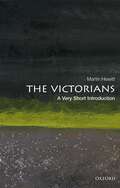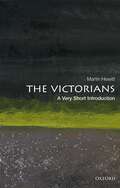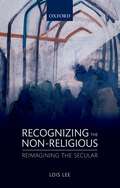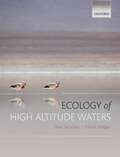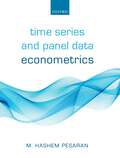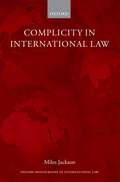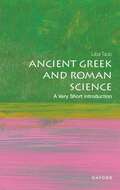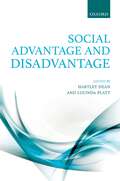- Table View
- List View
The Victorians: A Very Short Introduction (Very Short Introductions)
by Professor Martin HewittVery Short Introductions: Brilliant, Sharp, Inspiring The Victorian period may have come to an end over 120 years ago, but the Victorians continue to be a vital presence in the modern world. Contemporary Britain is still in large part Victorian in its transport networks, sewage systems, streets, and houses. Victorian cultural legacies, especially in art, science, and literature, are still celebrated. The first to have to grapple with many of the challenges of modern urban society, we continue to look to the Victorians for inspiration and solace. And we are increasingly aware of the ways their global actions shaped, often for ill, the world around us. Much mythologised, inexhaustibly controversial, the Victorians are an inescapable reference point for understanding the modern histories not just of Britain and its empire, but of the world. In The Victorians: A Very Short Introduction Martin Hewitt offers a guide through the thickets of judgement and debate which have grown around the period and its people, to offer a historical overview of the Victorians and their legacies. He seeks to answer five crucial questions. Why have the Victorians continued occupy such a prominent place in the cultures of not just the anglophone world? How far does it make sense to think of a 64-year period arbitrarily given an identity by the longevity of the Queen as an identifiable historical period in a general sense? How justified are the value-laden versions of the Victorians which argue for the existence of a particular world view called 'Victorianism'? Beyond ideology, what was Victorian Britain actually like – and in particular, what was distinctive about it? Who were the Victorians – not just the eminent few, but the population as a whole? And finally, how far and with what results did the Victorians and their culture spread across the globe? In answering these questions, Hewitt cautions against some long-held orthodoxies, throws a light on some less well-known aspects of the period, and urges the importance of understanding the Victorians on their own terms if we are to effectively engage with their legacies. ABOUT THE SERIES: The Very Short Introductions series from Oxford University Press contains hundreds of titles in almost every subject area. These pocket-sized books are the perfect way to get ahead in a new subject quickly. Our expert authors combine facts, analysis, perspective, new ideas, and enthusiasm to make interesting and challenging topics highly readable.
The Victorians: A Very Short Introduction (Very Short Introductions)
by Professor Martin HewittVery Short Introductions: Brilliant, Sharp, Inspiring The Victorian period may have come to an end over 120 years ago, but the Victorians continue to be a vital presence in the modern world. Contemporary Britain is still in large part Victorian in its transport networks, sewage systems, streets, and houses. Victorian cultural legacies, especially in art, science, and literature, are still celebrated. The first to have to grapple with many of the challenges of modern urban society, we continue to look to the Victorians for inspiration and solace. And we are increasingly aware of the ways their global actions shaped, often for ill, the world around us. Much mythologised, inexhaustibly controversial, the Victorians are an inescapable reference point for understanding the modern histories not just of Britain and its empire, but of the world. In The Victorians: A Very Short Introduction Martin Hewitt offers a guide through the thickets of judgement and debate which have grown around the period and its people, to offer a historical overview of the Victorians and their legacies. He seeks to answer five crucial questions. Why have the Victorians continued occupy such a prominent place in the cultures of not just the anglophone world? How far does it make sense to think of a 64-year period arbitrarily given an identity by the longevity of the Queen as an identifiable historical period in a general sense? How justified are the value-laden versions of the Victorians which argue for the existence of a particular world view called 'Victorianism'? Beyond ideology, what was Victorian Britain actually like – and in particular, what was distinctive about it? Who were the Victorians – not just the eminent few, but the population as a whole? And finally, how far and with what results did the Victorians and their culture spread across the globe? In answering these questions, Hewitt cautions against some long-held orthodoxies, throws a light on some less well-known aspects of the period, and urges the importance of understanding the Victorians on their own terms if we are to effectively engage with their legacies. ABOUT THE SERIES: The Very Short Introductions series from Oxford University Press contains hundreds of titles in almost every subject area. These pocket-sized books are the perfect way to get ahead in a new subject quickly. Our expert authors combine facts, analysis, perspective, new ideas, and enthusiasm to make interesting and challenging topics highly readable.
Emperors and Ancestors: Roman Rulers and the Constraints of Tradition (Oxford Studies in Ancient Culture & Representation)
by Olivier HeksterAncestry played a continuous role in the construction and portrayal of Roman emperorship in the first three centuries AD. Emperors and Ancestors is the first systematic analysis of the different ways in which imperial lineage was represented in the various 'media' through which images of emperors could be transmitted. Looking beyond individual rulers, Hekster evaluates evidence over an extended period of time and differentiates between various types of sources, such as inscriptions, sculpture, architecture, literary text, and particularly central coinage, which forms the most convenient source material for a modern reconstruction of Roman representations over a prolonged period of time. The volume explores how the different media in use sent out different messages. The importance of local notions and traditions in the choice of local representations of imperial ancestry are emphasized, revealing that there was no monopoly on image-forming by the Roman centre and far less interaction between central and local imagery than is commonly held. Imperial ancestry is defined through various parallel developments at Rome and in the provinces. Some messages resonated outside the centre but only when they were made explicit and fitted local practice and the discourse of the medium. The construction of imperial ancestry was constrained by the local expectations of how a ruler should present himself, and standardization over time of the images and languages that could be employed in the 'media' at imperial disposal. Roman emperorship is therefore shown to be a constant process of construction within genres of communication, representation, and public symbolism.
Forensic Shakespeare (Clarendon Lectures in English)
by Quentin SkinnerForensic Shakespeare illustrates Shakespeare's creative processes by revealing the intellectual materials out of which some of his most famous works were composed. Focusing on the narrative poem Lucrece, on four of his late Elizabethan plays (Romeo and Juliet, The Merchant of Venice, Julius Caesar and Hamlet) and on three early Jacobean dramas, (Othello, Measure for Measure and All's Well That Ends Well), Quentin Skinner argues that major speeches, and sometimes sequences of scenes, are crafted according to a set of rhetorical precepts about how to develop a persuasive judicial case, either in accusation or defence. Some of these works have traditionally been grouped together as 'problem plays', but here Skinner offers a different explanation for their frequent similarities of tone. There have been many studies of Shakespeare's rhetoric, but they have generally concentrated on his wordplay and use of figures and tropes. By contrast, this study concentrates on Shakespeare's use of judicial rhetoric as a method of argument. By approaching the plays from this perspective, Skinner is able to account for some distinctive features of Shakespeare's vocabulary, and also help to explain why certain scenes follow a recurrent pattern and arrangement. More broadly, he is able to illustrate the extent of Shakespeare's engagement with an entire tradition of classical and Renaissance humanist thought.
Forensic Shakespeare (Clarendon Lectures in English)
by Quentin SkinnerForensic Shakespeare illustrates Shakespeare's creative processes by revealing the intellectual materials out of which some of his most famous works were composed. Focusing on the narrative poem Lucrece, on four of his late Elizabethan plays (Romeo and Juliet, The Merchant of Venice, Julius Caesar and Hamlet) and on three early Jacobean dramas, (Othello, Measure for Measure and All's Well That Ends Well), Quentin Skinner argues that major speeches, and sometimes sequences of scenes, are crafted according to a set of rhetorical precepts about how to develop a persuasive judicial case, either in accusation or defence. Some of these works have traditionally been grouped together as 'problem plays', but here Skinner offers a different explanation for their frequent similarities of tone. There have been many studies of Shakespeare's rhetoric, but they have generally concentrated on his wordplay and use of figures and tropes. By contrast, this study concentrates on Shakespeare's use of judicial rhetoric as a method of argument. By approaching the plays from this perspective, Skinner is able to account for some distinctive features of Shakespeare's vocabulary, and also help to explain why certain scenes follow a recurrent pattern and arrangement. More broadly, he is able to illustrate the extent of Shakespeare's engagement with an entire tradition of classical and Renaissance humanist thought.
Recognizing the Non-religious: Reimagining the Secular
by Lois LeeIn recent years, the extent to which contemporary societies are secular has come under scrutiny. At the same time, many countries, especially in Europe, have increasingly large nonaffiliate, 'subjectively secular' populations, whilst nonreligious cultural movements like the New Atheism and the Sunday Assembly have come to prominence. Making sense of secularity, irreligion, and the relationship between them has therefore emerged as a crucial task for those seeking to understand contemporary societies and the nature of modern life. Drawing on ethnographic fieldwork in southeast England, Recognizing the Non-religious develops a new vocabulary, theory and methodology for thinking about the secular. It distinguishes between separate and incommensurable aspects of so-called secularity as insubstantial—involving merely the absence of religion—and substantial—involving beliefs, ritual practice, and identities that are alternative to religious ones. Recognizing the cultural forms that present themselves as non-religious therefore opens up new, more egalitarian and more theoretically coherent ways of thinking about people who are 'not religious'. It is also argued that recognizing the nonreligious allows us to reimagine the secular itself in new and productive ways. This book is part of a fast-growing area of research that builds upon and contributes to theoretical debates concerning secularization, 'desecularization', religious change, postsecularity and postcolonial approaches to religion and secularism. As well as presenting new research, this book gathers insights from the wider studies of nonreligion, atheism, and secularism in order to consolidate a theoretical framework, conceptual foundation and agenda for future research.
Ecology of High Altitude Waters
by Dean Jacobsen Olivier DanglesTruly high altitude aquatic ecosystems are found primarily at lower latitudes: vast regions in the tropical part of the Andes, the Himalayas and Tibet, considerable areas in East Africa, and minor zones of Oceania. However, despite their abundance in these regions, their biology and ecology has never been summarized in detail. A current synthesis of the topic is therefore timely. High altitude waters are ideal systems with which to address a broad range of key and topical themes in ecology, both at the regional and global scales. From specific functional adaptations of aquatic species to harsh environmental conditions through to global diversity patterns along altitudinal gradients and extinction risks of mountain populations due to vanishing glaciers, ecological patterns and processes found in high altitude waters are both diverse and singular. Although poorly considered in classical textbooks of ecology and limnology, high altitude waters have much to offer existing (aquatic) ecological theories and applications. These often threatened and exploited habitats are also ideal for studying the intimate interactions between social and ecological systems that characterize the majority of ecosystems in the Anthropocene.
Time Series and Panel Data Econometrics
by M. Hashem PesaranThis book is concerned with recent developments in time series and panel data techniques for the analysis of macroeconomic and financial data. It provides a rigorous, nevertheless user-friendly, account of the time series techniques dealing with univariate and multivariate time series models, as well as panel data models. It is distinct from other time series texts in the sense that it also covers panel data models and attempts at a more coherent integration of time series, multivariate analysis, and panel data models. It builds on the author's extensive research in the areas of time series and panel data analysis and covers a wide variety of topics in one volume. Different parts of the book can be used as teaching material for a variety of courses in econometrics. It can also be used as reference manual. It begins with an overview of basic econometric and statistical techniques, and provides an account of stochastic processes, univariate and multivariate time series, tests for unit roots, cointegration, impulse response analysis, autoregressive conditional heteroskedasticity models, simultaneous equation models, vector autoregressions, causality, forecasting, multivariate volatility models, panel data models, aggregation and global vector autoregressive models (GVAR). The techniques are illustrated using Microfit 5 (Pesaran and Pesaran, 2009, OUP) with applications to real output, inflation, interest rates, exchange rates, and stock prices.
Modality and Explanatory Reasoning
by Boris KmentSince the ground-breaking work of Saul Kripke, David Lewis, and others in the 1960s and 70s, one dominant interest of analytic philosophers has been in modal truths, which concerns the questions of what is possible and what is necessary. However, there is considerable controversy over the source and nature of necessity. In Modality and Explanatory Reasoning, Boris Kment takes a novel approach to the study of modality that places special emphasis on understanding the origin of modal notions in everyday thought. Kment argues that the concepts of necessity and possibility originate in a common type of thought experiment—counterfactual reasoning—that allows us to investigate explanatory connections. This procedure is closely related to the controlled experiments of empirical science. Necessity is defined in terms of causation and other forms of explanation such as grounding, the relation that connects metaphysically fundamental facts to non-fundamental ones. Therefore, contrary to a widespread view, explanation is more fundamental than modality. The study of modal facts is important for philosophy, not because these facts are of much metaphysical interest in their own right, but because they provide evidence about explanatory relationships. In the course of developing this position, the book offers new accounts of possible worlds, counterfactual conditionals, essential truths and their role in grounding, and a novel theory of how counterfactuals relate to causation and explanation.
The Law of International Watercourses (Oxford International Law Library)
by Stephen C. McCaffreyThe Law of International Watercourses is an authoritative guide to the rules of international law governing the navigational and non-navigational uses of international rivers, lakes, and groundwater. The continued growth of the world's population places increasing demands on Earth's finite supplies of fresh water. Because two or more States share many of the world's most important drainage basins - including the Danube, the Ganges, the Indus, the Jordan, the Mekong, the Nile, the Rhine and the Tigris-Euphrates - competition for increasingly scarce fresh water resources will only increase. Agreements between the States sharing international watercourses are negotiated, and disputes over shared water are resolved, against the backdrop of the rules of international law governing the use of this precious resource. The basic legal rules governing the use of shared freshwater for purposes other than navigation are reflected in the 1997 UN Convention on the Law of the Non-Navigational Uses of International Watercourses. This book devotes a chapter to the 1997 Convention but also examines the factual and legal context in which the Convention should be understood, considers the more important rules of the Convention in some depth, and discusses specific issues that could not be addressed in a framework instrument of that kind. The book reviews the major cases and controversies concerning international watercourses as a background against which to consider the basic substantive and procedural rights and obligations of States in the field. The third edition covers the implications of the 1997 Convention coming into force in August 2014, and the compatibility of the 1997 and 1992 Conventions. This edition also updates the entire book, adds new material to many of the chapters, and adds a number of new case studies, including Pulp Mills on the River Uruguay (Argentina v. Uruguay) and Certain Activities carried out by Nicaragua in the Border Area (Costa Rica v. Nicaragua), amongst others.
The Law of International Watercourses (Oxford International Law Library)
by Stephen C. McCaffreyThe Law of International Watercourses is an authoritative guide to the rules of international law governing the navigational and non-navigational uses of international rivers, lakes, and groundwater. The continued growth of the world's population places increasing demands on Earth's finite supplies of fresh water. Because two or more States share many of the world's most important drainage basins - including the Danube, the Ganges, the Indus, the Jordan, the Mekong, the Nile, the Rhine and the Tigris-Euphrates - competition for increasingly scarce fresh water resources will only increase. Agreements between the States sharing international watercourses are negotiated, and disputes over shared water are resolved, against the backdrop of the rules of international law governing the use of this precious resource. The basic legal rules governing the use of shared freshwater for purposes other than navigation are reflected in the 1997 UN Convention on the Law of the Non-Navigational Uses of International Watercourses. This book devotes a chapter to the 1997 Convention but also examines the factual and legal context in which the Convention should be understood, considers the more important rules of the Convention in some depth, and discusses specific issues that could not be addressed in a framework instrument of that kind. The book reviews the major cases and controversies concerning international watercourses as a background against which to consider the basic substantive and procedural rights and obligations of States in the field. The third edition covers the implications of the 1997 Convention coming into force in August 2014, and the compatibility of the 1997 and 1992 Conventions. This edition also updates the entire book, adds new material to many of the chapters, and adds a number of new case studies, including Pulp Mills on the River Uruguay (Argentina v. Uruguay) and Certain Activities carried out by Nicaragua in the Border Area (Costa Rica v. Nicaragua), amongst others.
Complicity in International Law (Oxford Monographs in International Law)
by Miles JacksonThis book examines how international law prohibits state and individual complicity. Complicity is a derivative form of responsibility that links an accomplice to the wrongdoing of a principal actor. Whenever a legal system prohibits complicity, it must address certain questions as to the content and structure of the rules. To understand how international law answers these questions, this book proposes an analytical framework in which complicity rules may be assessed and defends a normative claim as to how they should be structured. Anchored by this framework and normative claim, this book shows that international criminal law regulates individual complicity in a comprehensive way, using the doctrines of instigation and aiding and abetting to inculpate complicit participants in international crimes. By contrast, international law's regulation of state complicity was historically marked by an absence of complicity rules. This is changing. In respect of state complicity in the wrongdoing of another state, international law now imposes both specific and general complicity obligations, the latter prohibiting states from aiding or assisting another state in the commission of any internationally wrongful act. In respect of the ways that states participate in harms caused by non-state actors, the traditional normative structure of international law, which imposed obligations only on states, foreclosed the possibility of prohibiting the state's participation as a form of complicity. As that traditional normative structure has evolved, so the possibility of holding states responsible for complicity in the wrongdoing of non-state actors has emerged. More and more, both the wrongs that international actors commit, and the wrongs they help or encourage others to commit, matter.
Complicity in International Law (Oxford Monographs in International Law)
by Miles JacksonThis book examines how international law prohibits state and individual complicity. Complicity is a derivative form of responsibility that links an accomplice to the wrongdoing of a principal actor. Whenever a legal system prohibits complicity, it must address certain questions as to the content and structure of the rules. To understand how international law answers these questions, this book proposes an analytical framework in which complicity rules may be assessed and defends a normative claim as to how they should be structured. Anchored by this framework and normative claim, this book shows that international criminal law regulates individual complicity in a comprehensive way, using the doctrines of instigation and aiding and abetting to inculpate complicit participants in international crimes. By contrast, international law's regulation of state complicity was historically marked by an absence of complicity rules. This is changing. In respect of state complicity in the wrongdoing of another state, international law now imposes both specific and general complicity obligations, the latter prohibiting states from aiding or assisting another state in the commission of any internationally wrongful act. In respect of the ways that states participate in harms caused by non-state actors, the traditional normative structure of international law, which imposed obligations only on states, foreclosed the possibility of prohibiting the state's participation as a form of complicity. As that traditional normative structure has evolved, so the possibility of holding states responsible for complicity in the wrongdoing of non-state actors has emerged. More and more, both the wrongs that international actors commit, and the wrongs they help or encourage others to commit, matter.
Sjögren's Syndrome (Oxford Rheumatology Library)
Primary Sjögren's syndrome is a rheumatic disease affecting around 0.1-0.2% of the adult female population and can result in significant disability without adequate therapy. Diagnosis is often delayed and suggested therapies may not be optimal, and a multidisciplinary approach that includes rheumatologists, ophthalmologists, oral medicine physicians, and others is important to patient management. This volume summarises current understanding of the pathogenesis of the disease, including advances in the genetics of Sjögren's syndrome. Chapters cover disease mechanisms, clinical diagnosis and assessment, secondary Sjögren's syndrome, the role of laboratory investigations, and imaging. A therapy-based section covers topical oral and ocular therapies, and the role of steroids and biologics are also addressed. Sjögren's Syndrome is a practical concise pocketbook featuring key points and illustrations showing important mechanisms of disease and pathways of care. The book will be of interest to trainees in rheumatology, ophthalmology, and oral medicine/surgery; specialist practitioners and therapists involved in the care of patients with Sjögren's syndrome; and primary care physicians, dentists, and other specialists such as ENT physicians.
Sjögren's Syndrome (Oxford Rheumatology Library)
by Wan-Fai NgPrimary Sjögren's syndrome is a rheumatic disease affecting around 0.1-0.2% of the adult female population and can result in significant disability without adequate therapy. Diagnosis is often delayed and suggested therapies may not be optimal, and a multidisciplinary approach that includes rheumatologists, ophthalmologists, oral medicine physicians, and others is important to patient management. This volume summarises current understanding of the pathogenesis of the disease, including advances in the genetics of Sjögren's syndrome. Chapters cover disease mechanisms, clinical diagnosis and assessment, secondary Sjögren's syndrome, the role of laboratory investigations, and imaging. A therapy-based section covers topical oral and ocular therapies, and the role of steroids and biologics are also addressed. Sjögren's Syndrome is a practical concise pocketbook featuring key points and illustrations showing important mechanisms of disease and pathways of care. The book will be of interest to trainees in rheumatology, ophthalmology, and oral medicine/surgery; specialist practitioners and therapists involved in the care of patients with Sjögren's syndrome; and primary care physicians, dentists, and other specialists such as ENT physicians.
Ancient Greek and Roman Science: A Very Short Introduction (Very Short Introductions)
by Liba TaubVery Short Introductions: Brilliant, Sharp, Inspiring Ancient Greece is often considered to be the birthplace of science and medicine, and the explanation of natural phenomena without recourse to supernatural causes. The early natural philosophers - lovers of wisdom concerning nature - sought to explain the order and composition of the world, and how we come to know it. They were particularly interested in what exists and how it is ordered: ontology and cosmology. They were also concerned with how we come to know (epistemology) and how best to live (ethics). At the same time, the scientific thinkers of early Greece and Rome were also influenced by ideas from other parts of the world, and incorporated aspects of Egyptian, Babylonian, and Indian science and mathematics in their studies. In this Very Short Introduction Liba Taub gives an overview of the major developments in early science between the 8th century BCE and 6th century CE. Focussing on Greece and Rome, Taub challenges a number of modern misconceptions about science in the classical world, which has often been viewed with a modern lens and by modern scientists, such as the misconception that little empirical work was conducted, or that the Romans did not 'do' science, unlike the Greeks. Beginning with the scientific notions of Thales, Pythagoras, Parmenides and other Presocratics, she moves on to Plato and Aristotle, before considering Hellenistic science, the influence of the Stoics and Epicurean ideas, and the works of Pliny the Elder, Eratosthenes, and Ptolemy. In her sweeping discussion, Taub explores the richness and creativity of ideas concerning the natural world, and the influence these ideas have had on later centuries. ABOUT THE SERIES: The Very Short Introductions series from Oxford University Press contains hundreds of titles in almost every subject area. These pocket-sized books are the perfect way to get ahead in a new subject quickly. Our expert authors combine facts, analysis, perspective, new ideas, and enthusiasm to make interesting and challenging topics highly readable.
Ancient Greek and Roman Science: A Very Short Introduction (Very Short Introductions)
by Liba TaubVery Short Introductions: Brilliant, Sharp, Inspiring Ancient Greece is often considered to be the birthplace of science and medicine, and the explanation of natural phenomena without recourse to supernatural causes. The early natural philosophers - lovers of wisdom concerning nature - sought to explain the order and composition of the world, and how we come to know it. They were particularly interested in what exists and how it is ordered: ontology and cosmology. They were also concerned with how we come to know (epistemology) and how best to live (ethics). At the same time, the scientific thinkers of early Greece and Rome were also influenced by ideas from other parts of the world, and incorporated aspects of Egyptian, Babylonian, and Indian science and mathematics in their studies. In this Very Short Introduction Liba Taub gives an overview of the major developments in early science between the 8th century BCE and 6th century CE. Focussing on Greece and Rome, Taub challenges a number of modern misconceptions about science in the classical world, which has often been viewed with a modern lens and by modern scientists, such as the misconception that little empirical work was conducted, or that the Romans did not 'do' science, unlike the Greeks. Beginning with the scientific notions of Thales, Pythagoras, Parmenides and other Presocratics, she moves on to Plato and Aristotle, before considering Hellenistic science, the influence of the Stoics and Epicurean ideas, and the works of Pliny the Elder, Eratosthenes, and Ptolemy. In her sweeping discussion, Taub explores the richness and creativity of ideas concerning the natural world, and the influence these ideas have had on later centuries. ABOUT THE SERIES: The Very Short Introductions series from Oxford University Press contains hundreds of titles in almost every subject area. These pocket-sized books are the perfect way to get ahead in a new subject quickly. Our expert authors combine facts, analysis, perspective, new ideas, and enthusiasm to make interesting and challenging topics highly readable.
The Oxford Handbook of the Corporation (Oxford Handbooks)
The Oxford Handbook of the Corporation assesses the contemporary relevance, purpose, and performance of the corporation. The corporation is one of the most significant, if contested, innovations in human history, and the direction and effectiveness of corporate law, corporate governance, and corporate performance are being challenged as never before. Continuously evolving, the corporation as the primary instrument for wealth generation in contemporary economies demands frequent assessment and reinterpretation. The focus of this work is the transformative impact of innovation and change upon corporate structure, purpose, and operation. Corporate innovation is at the heart of the value-creation process in increasingly internationalized and competitive market economies, and corporations today are embedded in a world of complex global supply chains and rising state and state-directed capitalism. In questioning the fundamental purpose and performance of the corporation, this Handbook continues a tradition commenced by Berle and Means, and contributed to by generations of business scholars. What is the corporation and what is it becoming? How do we define its form and purpose and how are these changing? To whom is the corporation responsible, and who should judge the ultimate performance of corporations? By investigating the origins, development, strategies, and theories of corporations, this volume addresses such questions to provide a richer theoretical account of the corporation and its contested future.
The Oxford Handbook of the Corporation (Oxford Handbooks)
by Justin O'Brien Thomas Clarke Charles O'KelleyThe Oxford Handbook of the Corporation assesses the contemporary relevance, purpose, and performance of the corporation. The corporation is one of the most significant, if contested, innovations in human history, and the direction and effectiveness of corporate law, corporate governance, and corporate performance are being challenged as never before. Continuously evolving, the corporation as the primary instrument for wealth generation in contemporary economies demands frequent assessment and reinterpretation. The focus of this work is the transformative impact of innovation and change upon corporate structure, purpose, and operation. Corporate innovation is at the heart of the value-creation process in increasingly internationalized and competitive market economies, and corporations today are embedded in a world of complex global supply chains and rising state and state-directed capitalism. In questioning the fundamental purpose and performance of the corporation, this Handbook continues a tradition commenced by Berle and Means, and contributed to by generations of business scholars. What is the corporation and what is it becoming? How do we define its form and purpose and how are these changing? To whom is the corporation responsible, and who should judge the ultimate performance of corporations? By investigating the origins, development, strategies, and theories of corporations, this volume addresses such questions to provide a richer theoretical account of the corporation and its contested future.
Social Advantage and Disadvantage
Social advantage and disadvantage are potent catch-all terms. They have no established definition but, considered in relation to one another, they can embrace a wide variety of more specific concepts that address the ways in which human society causes, exacerbates or fails to prevent social divisions or injustices. This book captures the sense in which any conceptualisation of disadvantage is concerned with the consequences of processes by which relative advantage has been selectively conferred or attained. It considers how inequalities and social divisions are created as much by the concentration of advantage among the best-off as by the systematic disadvantage of the worst-off. The book critically discusses - from a global and a UK perspective - a spectrum of conceptual frameworks and ideas relating to poverty, social exclusion, capability deprivation, rights violations, social immobility, and human or social capital deficiency. It addresses advantage and disadvantage from a life course perspective through discussions of family and childhood, education, work, old age, and the dynamics of income and wealth. It considers cross-cutting divides that are implicated in the social construction and maintenance of advantage and disadvantage, including divisions premised on gender, 'race', ethnicity, migration and religion, neighbourhood and the experience of crime.
Social Advantage and Disadvantage
by Hartley Dean Lucinda PlattSocial advantage and disadvantage are potent catch-all terms. They have no established definition but, considered in relation to one another, they can embrace a wide variety of more specific concepts that address the ways in which human society causes, exacerbates or fails to prevent social divisions or injustices. This book captures the sense in which any conceptualisation of disadvantage is concerned with the consequences of processes by which relative advantage has been selectively conferred or attained. It considers how inequalities and social divisions are created as much by the concentration of advantage among the best-off as by the systematic disadvantage of the worst-off. The book critically discusses - from a global and a UK perspective - a spectrum of conceptual frameworks and ideas relating to poverty, social exclusion, capability deprivation, rights violations, social immobility, and human or social capital deficiency. It addresses advantage and disadvantage from a life course perspective through discussions of family and childhood, education, work, old age, and the dynamics of income and wealth. It considers cross-cutting divides that are implicated in the social construction and maintenance of advantage and disadvantage, including divisions premised on gender, 'race', ethnicity, migration and religion, neighbourhood and the experience of crime.
Locke's Touchy Subjects: Materialism and Immortality
by Nicholas JolleyIn seventeenth-century philosophy the mind-body problem and the nature of personal immortality were two of the most controversial and sensitive issues. Nicholas Jolley seeks to show that these issues are more prominent in Locke's philosophy than has been realized. He argues further that Locke takes up unorthodox positions in both cases. Although Locke's official stance on the mind-body problem is agnostic, in places he presents arguments that, taken together, amount to a significant case for a weak form of materialism. Locke also seeks to show that the solution to the mind-body problem is irrelevant to the issue of personal immortality: for Locke, such immortality is conceptually possible even if the same body is not resurrected at the Day of Judgment. Jolley throws new light on such central topics in An Essay Concerning Human Understanding as substance and personal identity: he also pays close attention to such neglected topics as his account of the status of animals and his polemic against the thesis that the mind always thinks. Throughout, the book examines Locke's arguments against the background of Descartes' views. Jolley argues that Locke's criticisms of Descartes are no mere defences of common sense against dogmatism; rather, they are controversial responses to some of the most challenging metaphysical and theological issues of his time.
Locke's Touchy Subjects: Materialism and Immortality
by Nicholas JolleyIn seventeenth-century philosophy the mind-body problem and the nature of personal immortality were two of the most controversial and sensitive issues. Nicholas Jolley seeks to show that these issues are more prominent in Locke's philosophy than has been realized. He argues further that Locke takes up unorthodox positions in both cases. Although Locke's official stance on the mind-body problem is agnostic, in places he presents arguments that, taken together, amount to a significant case for a weak form of materialism. Locke also seeks to show that the solution to the mind-body problem is irrelevant to the issue of personal immortality: for Locke, such immortality is conceptually possible even if the same body is not resurrected at the Day of Judgment. Jolley throws new light on such central topics in An Essay Concerning Human Understanding as substance and personal identity: he also pays close attention to such neglected topics as his account of the status of animals and his polemic against the thesis that the mind always thinks. Throughout, the book examines Locke's arguments against the background of Descartes' views. Jolley argues that Locke's criticisms of Descartes are no mere defences of common sense against dogmatism; rather, they are controversial responses to some of the most challenging metaphysical and theological issues of his time.
The Nietzschean Self: Moral Psychology, Agency, and the Unconscious
by Paul KatsafanasNietzsche's works are replete with discussions of moral psychology, but to date there has been no systematic analysis of his account. How does Nietzsche understand human motivation, deliberation, agency, and selfhood? How does his account of the unconscious inform these topics? What is Nietzsche's conception of freedom, and how do we become free? Should freedom be a goal for all of us? How does—and how should—the individual relate to his social context? The Nietzschean Self offers a clear, comprehensive analysis of these central topics in Nietzsche's moral psychology. It analyzes his distinction between conscious and unconscious mental events, explains the nature of a type of motivational state that Nietzsche calls the 'drive', and examines the connection between drives, desires, affects, and values. It explores Nietzsche's account of willing unity of the self, freedom, and the relation of the self to its social and historical context. The Nietzschean Self argues that Nietzsche's account enjoys a number of advantages over the currently dominant models of moral psychology—especially those indebted to the work of Aristotle, Hume, and Kant—and considers the ways in which Nietzsche's arguments can reconfigure and improve upon debates in the contemporary literature on moral psychology and philosophy of action.
The Nietzschean Self: Moral Psychology, Agency, and the Unconscious
by Paul KatsafanasNietzsche's works are replete with discussions of moral psychology, but to date there has been no systematic analysis of his account. How does Nietzsche understand human motivation, deliberation, agency, and selfhood? How does his account of the unconscious inform these topics? What is Nietzsche's conception of freedom, and how do we become free? Should freedom be a goal for all of us? How does—and how should—the individual relate to his social context? The Nietzschean Self offers a clear, comprehensive analysis of these central topics in Nietzsche's moral psychology. It analyzes his distinction between conscious and unconscious mental events, explains the nature of a type of motivational state that Nietzsche calls the 'drive', and examines the connection between drives, desires, affects, and values. It explores Nietzsche's account of willing unity of the self, freedom, and the relation of the self to its social and historical context. The Nietzschean Self argues that Nietzsche's account enjoys a number of advantages over the currently dominant models of moral psychology—especially those indebted to the work of Aristotle, Hume, and Kant—and considers the ways in which Nietzsche's arguments can reconfigure and improve upon debates in the contemporary literature on moral psychology and philosophy of action.
